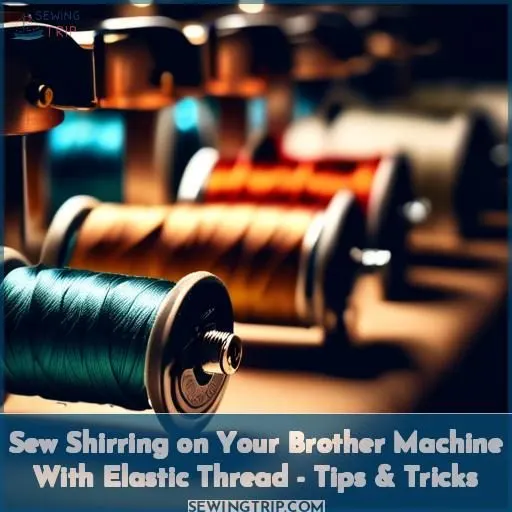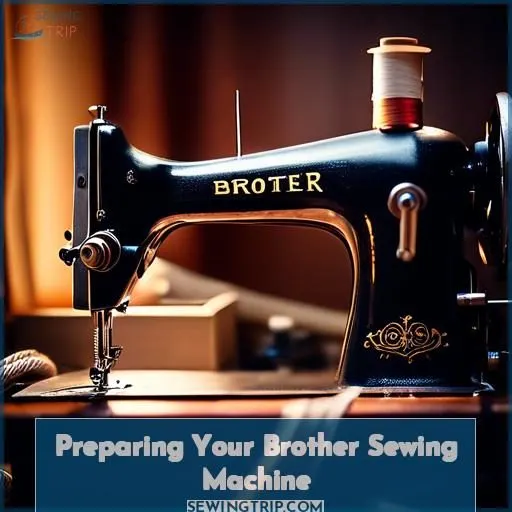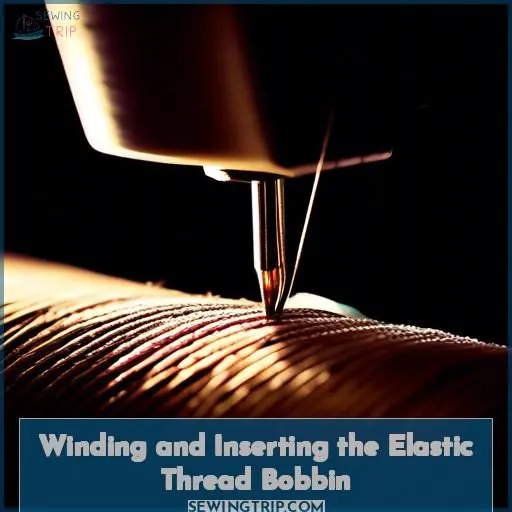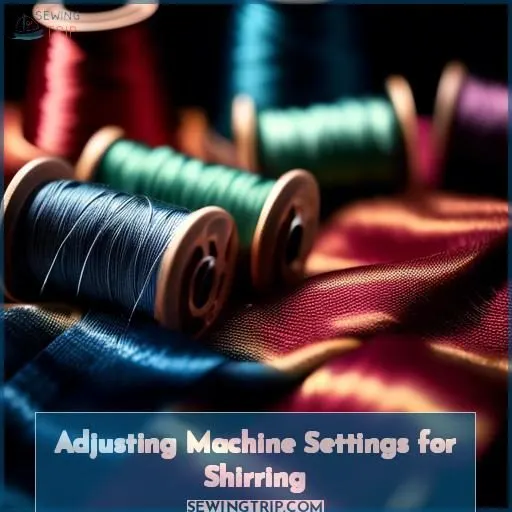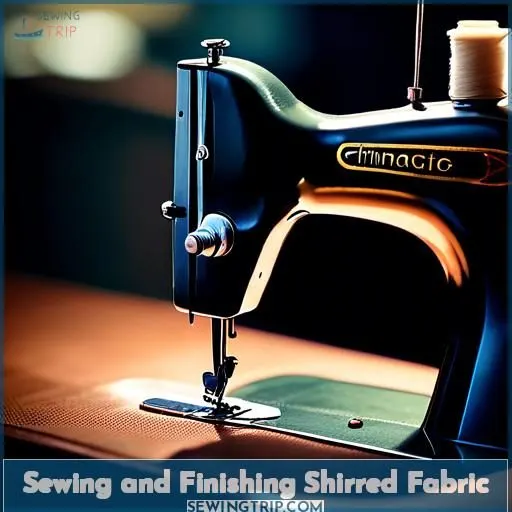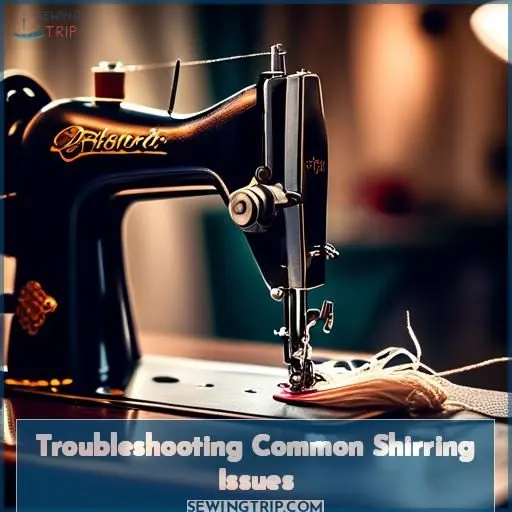This site is supported by our readers. We may earn a commission, at no cost to you, if you purchase through links.
To use elastic thread in your Brother sewing machine for shirring, first prepare your machine by setting a straight stitch, left needle position, and the longest stitch length. Choose the right fabric and needle size, then turn up the tension near its maximum.
Next, hand-wind the elastic thread onto the bobbin gently and consistently, avoiding overfilling. Insert the bobbin and sew rows of stitches, adjusting the bobbin tension to achieve the desired gathering.
Finish by steaming and tightening the stitches. Troubleshoot any issues by tweaking the bobbin tension and selecting high-quality elastic thread.
Table Of Contents
- Key Takeaways
- How to Use Elastic Thread in a Brother Sewing Machine?
- Preparing Your Brother Sewing Machine
- Winding and Inserting the Elastic Thread Bobbin
- Adjusting Machine Settings for Shirring
- Sewing and Finishing Shirred Fabric
- Troubleshooting Common Shirring Issues
- Frequently Asked Questions (FAQs)
- Conclusion
Key Takeaways
- Prepare the machine by setting a straight stitch, left needle position, and the longest stitch length.
- Hand-wind the elastic thread onto the bobbin gently and consistently, avoiding overfilling.
- Adjust the bobbin tension to achieve the desired gathering.
- Troubleshoot any issues by tweaking the bobbin tension and selecting high-quality elastic thread.
How to Use Elastic Thread in a Brother Sewing Machine?
To use elastic thread in a Brother sewing machine for shirring, follow these steps:
- Hand wind the bobbin with elastic thread carefully, making sure not to stretch it.
- Place the bobbin into the bobbin case and then into the machine as usual.
- Turn the balance wheel of your sewing machine to bring up the elastic thread through the throat plate.
- If your sewing machine has a drop-in bobbin, make sure the elastic thread is hooked into the groove.
- Set the stitch length to about 3.5 mm for shirring.
- Mark the fabric for shirring on the right side, using pins to poke through all layers.
- Flip the fabric over to see the pins poking through, then use masking tape to attach the pattern piece.
Remember to use all-purpose thread in the needle and sew rows of stitches 3/8 – 1/2 apart with a 3-4mm stitch length. For best results, test the tension on fabric scraps before starting your project.
Preparing Your Brother Sewing Machine
To prepare your Brother sewing machine for shirring with elastic thread, start by setting up the machine with a straight stitch and left needle position. Choose the right fabric and needle size for your project. Adjust the tension to high, near the maximum, and set the stitch length to the longest setting. Make sure the thread matches the fabric.
Before you start sewing, make a test piece to check the machine’s performance.
Remember to keep the thread tails at row ends and pull the top thread to the back, tying a knot to secure the stitches.
Winding and Inserting the Elastic Thread Bobbin
To start shirring on your Brother sewing machine, you’ll need to hand-wind the elastic thread onto the bobbin. Once the bobbin is ready, insert it into your machine following the standard bobbin insertion steps.
Hand-winding Techniques
Winding your elastic thread bobbin by hand is a key step in the shirring process. Here’s how to do it:
- Wind Gently and Consistently: Start winding the elastic thread onto the bobbin by hand. Wind gently and consistently to guarantee proper tension.
- Do Not Fill Entirely: Avoid overfilling the bobbin. Leave some space for the elastic thread to stretch during stitching.
- Wind Multiple Bobbins: If you’re working on a large project, wind multiple bobbins to guarantee you have enough thread.
Bobbin Insertion Steps
To insert and wind the elastic thread bobbin on your Brother sewing machine, follow these steps:
- Hand-wind the elastic thread onto the bobbin by winding gradually and evenly. Make sure not to fill the bobbin entirely, as this can cause overfilling and tension problems.
- Wind several bobbins to guarantee sufficient thread for your project.
- Check the remaining thread while stitching to prevent running out in the middle of the project.
- Once wound, insert the bobbin into the machine by dropping it into the bobbin case.
- Thread the upper thread system and needle as usual.
- Turn the handwheel in your direction to wind the bobbin thread up through the throat plate.
- Pull out several inches of thread to ensure proper tension.
Remember to adjust the bobbin tension if necessary for the best shirring results.
Adjusting Machine Settings for Shirring
Adjusting your machine settings is essential for successful shirring with elastic thread. Set your stitch length to the most extensive setting and increase the upper tension near the maximum to get that extra bounce in your fabric.
Stitch Length and Tension
To obtain the most satisfactory outcomes when shirring with elastic thread on your Brother sewing machine, alterations to your stitch length and tension settings are necessary. Here are four steps to guide you through the procedure:
- Stitch Tests: Initiate testing your stitch configurations to confirm that the elastic thread gathers the fabric efficiently. Aim for a stitch length that’s marginally longer than your customary settings.
- Tension Adjustments: Adjust the bobbin tension to induce a gathering effect. The tension ought to be tighter than your regular settings. This will allow the elastic thread to stretch and revert back to its original length, creating the desired gathering.
- Brother Machines: For Brother machines with drop-in bobbins, you may need to adjust the tension settings differently. Consult your machine’s manual or online resources for specific instructions.
- Lightweight Fabrics: Verify that you’re using lightweight fabrics, such as cotton voile or lawn, as they’re most suitable for shirring with elastic thread.
Remember to always commence with a clean machine and fresh thread prior to making adjustments. Experiment with diverse settings to ascertain the most suitable combination for your specific project.
Upper Tension Considerations
When shirring with your Brother machine, increasing the upper tension close to its maximum can feel like discovering a hidden ability. However, keep in mind that the equilibrium of machine tension, thread caliber, needle size, and fabric weight is crucial. Always create a sample swatch first. It serves as a guide for comprehending tension and transforming fabric with certainty.
Sewing and Finishing Shirred Fabric
Sew your rows of stitching with the elastic thread in the bobbin. Once you’ve finished sewing, hold your iron over the shirred fabric and give it a good steaming to tighten up the stitches and shrink the elastic.
Stitching Techniques
To guarantee a prosperous shirring encounter on your Brother sewing machine, it’s essential to heed stitching techniques. Commence by ascertaining the thread harmonizes with the fabric and the needle size is befitting for the fabric heft. Modify the stitch length and tension as required, aiming for a tight upper tension close to the maximum setting.
Execute a line of stitching without smoothening the fabric during the process. Subsequent to sewing, bring the top thread to the back and tie a knot. Secure the stitches by executing across the ends. Remember to maintain a consistent sewing pace for optimal stitch quality.
Finishing With Steam and Iron
To finish your shirred fabric, hold an iron over the stitching and steam it. Expect approximately 50% shrinkage, but this can vary based on machine settings, thread, and fabric weight.
Choose lightweight fabrics and adjust stitch length and tension as needed.
For best results, wind elastic thread tightly on Brother machines with drop-in bobbins.
Troubleshooting Common Shirring Issues
Are you struggling to get the perfect shirred effect on your Brother sewing machine? Adjusting the bobbin tension and carefully selecting your fabric and thread can make a world of difference.
Bobbin Tension Adjustments
To achieve successful shirring on your Brother sewing machine, it’s essential to adjust the bobbin tension. Here are three steps to help you achieve the desired results:
- Wind the bobbin with tension: When winding the bobbin with elastic thread, make sure that you apply some tension. This will help the elastic thread stretch and retract, creating the gathering effect.
- Set the stitch length: Adjust the stitch length to its longest setting. This allows the elastic thread to stretch and retract more easily, creating a gathering effect.
- Check the bobbin tension: After sewing a row of stitching, pull the top thread to the back and tie a knot. Then, sew across the row ends to anchor the stitches. If the fabric isn’t gathering as expected, you may need to adjust the bobbin tension.
Fabric and Thread Selection
Fabric weight and thread quality play a significant role in the success of your shirring project on your Brother sewing machine. Here’s what you need to know:
- Fabric Weight: Shirring works best with light and medium weight fabrics. Heavier fabrics may not shirr effectively, as they require more power to gather. Stick to lighter weight fabrics such as seersucker, cotton gauze, or quilting/fashion cotton for best results.
- Thread Quality: Make sure you use high-quality elastic thread for shirring. Low-quality thread may not hold up well during the shirring process, leading to uneven results. Invest in a good-quality elastic thread for the best possible outcomes.
Frequently Asked Questions (FAQs)
Can I use metal bobbins for shirring?
Sure, you can use metal bobbins for shirring, but they may not work as well as specialty bobbin cases. Try a few test runs to see what works best for your machine and project.
How does fabric type affect shirring results?
The fabric type greatly impacts your shirring results. Lightweight fabrics like cotton and linen work best, allowing the elastic threads to gather smoothly. Heavier fabrics may cause the stitches to pucker or distort. Experiment to find your ideal fabric match.
Is a special needle required for elastic thread?
You may not need a special needle, but the right one makes all the difference! With a little experimentation, you’ll discover the perfect pairing for fabulous shirring on your Brother machine. Get ready to wow with your elastic expertise!
Can shirring be done on all Brother models?
Shirring on Brother machines can vary – some models handle it better than others. With the right adjustments and techniques, you can get great shirring results, even on less-than-ideal Brother models. Experiment to find what works best for your machine.
How to store unused elastic thread bobbins?
Store unused elastic thread bobbins in an airtight container. This prevents the thread from drying out and losing its stretchiness. Pop ’em back in when you’re ready to get your shirr on!
Conclusion
Mastering the art of using stretchy thread in your Brother sewing machine for gathering is within your reach. By following the tips and tricks outlined in this article, you’ll be able to achieve beautiful, pleated fabric with ease. Remember to experiment with tension, stitch length, and high-quality threads to find the perfect combination for your project.
Express your creativity and let the magic of gathering transform your sewing endeavors.

